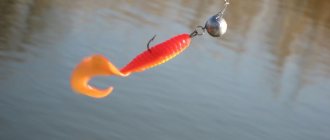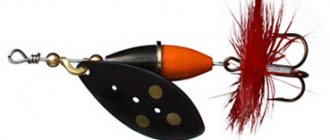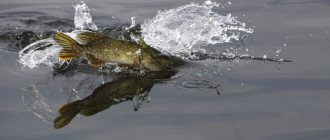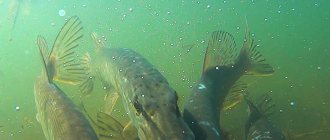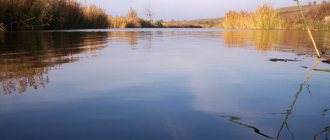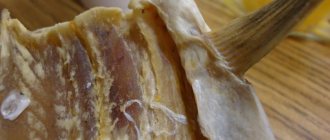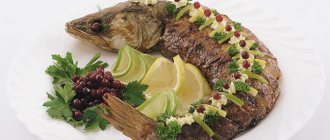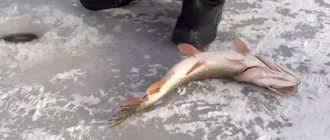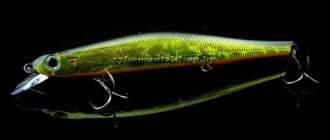Yuri 11/26/2020 92
What to do when it doesn’t bite and how to deal with it? This question would not be so relevant if we were talking about catching minnows or small perch, on a quiet evening on the river bank, just for fun. But how to solve the problem if the fishing was planned in advance and the object of the hunt is such a serious rival as pike?
Quite often you can hear the opinion from people who are far from fishing that the pike is stupid and unceremoniously grabs any bait. And if the toothy beast doesn’t bite, then it’s not in this place at all. This statement is dangerous because it becomes a dogma for many beginning spinning players. As a result of this, an inexperienced fisherman does not even try to find out the reason for the lack of bites. As a result, the baggage of experience is not replenished, the quality of fishing becomes worse.
Today we will talk about why a shortage of predator bites does not mean its absence in a particular place, as well as what tactics to choose for catching passive pike.
We invite you to look at our photos where fishermen show off the pike they caught at the Sazanya Bukhta fishing base.
Features of predator prey
We are dealing with a predator with a completely unpredictable character and special behavior. In this regard, several general aspects of its production can be identified:
- Regardless of the fishing method, specially strong rigs are installed on pike. The fact is that the predator has sharp teeth that can bite through any nylon in the blink of an eye. Therefore, metal or Kevlar leashes are used to extract it. If we are talking about inactive fish (for example, in the dead of winter or in July), you can use more delicate and less noticeable fluorocarbon braid.
- When going fishing, it is advisable not only to pre-sharpen your hooks, but also to take a needle file with you. The lips and palate of this fish are extremely hard, making it difficult to penetrate them. And to remove the hook from them, it is best to use a special extractor, a yawner or pliers: doing this with a knife is not very convenient, and with your hands it is simply dangerous: wounds from pike teeth are extremely painful and do not heal well.
- Having a watercraft makes fishing more productive. Large individuals love to stand in thickets or snags, attacking the bait from an ambush, so delivering the rig to the fishing site is often difficult. In this regard, in passive fishing methods it is recommended to use a boat: the splash of oars will not so much alert as it will interest a predator, especially one of impressive size - in its reservoir it feels like a full-fledged mistress.
When going after pike, be sure to take a landing net with you, and when fishing on ice, a special hook for removing the multi-kilogram toothy carcass from the water.
How to catch a pike when it doesn't want to bite?
Undoubtedly, the most desired trophy for a beginning spinning angler is a pike. In various “market” literature one can come across the opinion that pike is a stupid fish that attacks spinning baits as soon as they come into its field of vision. In practice, catching pike is not an easy task, especially where fishing pressure is very intense. The toothy predator tends to “sort out grub”; it does not rush at everything that floats under its nose. You need to find a key...
In order to understand in which direction to move, it is necessary to understand one point: the entire life cycle of a predatory fish is controlled solely by instincts. The pike does not have consciousness, which is a tool for analysis. Therefore, in order to provoke a predator to bite, you need to “press” on instinct. One of the main instincts that makes a fish attack the bait is, of course, hunger. If a pike wants to eat, it goes out hunting and gets its own food. In principle, a truly hungry pike is not picky, and with a high degree of probability will grab any spinner, wobbler, or silicone bait. However, it should be understood that pike goes hunting very rarely, and the larger the individual, the less often it shows high activity. The so-called “pike exit” can occur once a day and last only a few minutes. Getting to the exit is a great success for the spinner. This is almost a 100% guarantee of a bite.
However, the fisherman most often has to deal with a passive pike, which sits in its shelter and processes the contents of its stomach into energy. To catch such a pike, you already need to make some effort. There are several effective techniques for “seducing” a well-fed, inactive pike. I will be happy to talk about some of the most effective ones below.
If you come to a pike pond, find good places, but the toothy one doesn’t show itself in any way, the first thing you need to do is slow down the retrieve as much as possible. A passive pike will never waste its energy chasing bait. But if we give the pike time to slowly, with minimal effort, simply open its mouth and get free “prey”, the chances of success increase several times. Therefore, baits must be cast very slowly, making sure to pause during the retrieve. The most effective may be wobblers with neutral buoyancy, capable of hovering motionless in the water column. Pike attacks most often occur either directly during a pause or during the very first revolutions (jerks). The predator, which has approached the bait, understands that the prey may escape, and therefore grabs it.
Slow animations with pauses in 80% of cases solve the problem of no bite and the fish begin to bite. But sometimes the pike is in a “complete stupor”, and even if you play the bait right next to its nose, no reaction follows. In this case, you can try to radically change the approach and put some actively playing, “noisy” bait that will “irritate” the toothy one. Quite often, the pike can actually be stirred up; it begins to become interested in the bait, accompany it all the way to the boat, but at the same time completely refuses to attack it. In this case, you just need to unfasten the active bait from the leash, put something quiet, with a measured game, and try to catch the toothy one. In 8 out of 10 cases this succeeds!
If nothing works and you're starting to give up, try a completely unconventional approach. Pike is a sedentary fish that occupies a certain territory. And if there is a potential enemy on its territory who has gained the audacity to hunt in other people’s lands, the toothy one will most likely try to “punish” him (unless, of course, the individual in front of her is smaller in size). Knowing that a predator has a protective instinct, you can tie a leash rig consisting of a large bait, in front of which a small twister will dangle on a leash. When retrieving, such equipment creates the illusion of a predatory fish chasing a fry, and if it comes into the pike’s field of vision, an instant attack is likely to follow, regardless of the degree of satiety of the toothy one. However, I would like to note that most often, pike weighing up to a kilogram (usually 400-800 g) are caught on the hook. Large individuals do not care about the little ones that hunt small fry, even if this happens on its territory.
I hope that these tips will help you on your fishing trips and your catches will increase many times over. The main thing, friends, remember the “catch and release” principle. Take exactly as much fish as you need to treat your family to a delicious dinner in the evening. And the rest of the catch must be mercilessly drowned!
No tail, no scales.
Seasonal nuances of pike fishing
Pike feed almost all year round, but seasonal declines in activity and changes in behavior are observed. This is reflected in the choice of optimal fishing tactics.
Spring is the golden time for preying on this predator. This season, two periods of zhora stand out clearly: about a week before spawning and two after it. Pike spawn for about two weeks, in March, the first of all the inhabitants of our reservoirs, and during this period they are not interested in food at all. But during the feast, it is perfectly caught both with live bait and spinning rods, and in shallow water.
This bait provides a rich catch even with a bad bite!
More details With the onset of summer , the predator moves from shallow water to deeper areas, mainly into thickets, snags and other hard-to-reach places.
At this time, she can allow herself to be picky about food and not rush from afar to any bait - there is plenty of food around. At this time, it is especially important to accurately determine the location of the predator’s stand and present the bait directly to its toothy muzzle. In the fall , the predator becomes active again, leaves its cozy summer apartment and begins to patrol the pond in search of food. During this period, it is especially well caught with a spinning rod, because it rushes at everything that floats past, but hunts exclusively during the day - night fishing is futile.
In winter, pike are caught almost continuously: this is also a very productive time, especially during the first ice and before the opening of reservoirs. Its activity fades only during particularly stormy winters, but resumes with the onset of clear, stable weather.
Wobbler length for pike
From practice, we can say that pike wobblers in fishing conditions in our latitudes usually range in size from 5 to 13 centimeters. Moreover, small wobblers catch pike of small sizes, from “laces” weighing 150 grams to squinting 400-500 grams. Even if there is a large pike in the fishing area, it usually ignores a wobbler of this size. But once you place a large minnow, bites follow almost immediately.
With baits of “minor” geometry 6-7 centimeters long, you can catch both pike weighing half a kilo and quite respectable fish weighing up to three or four kilograms. But this only applies to lures with an oblong body - minnow.
Although, an excessive increase in the size of bait does not at all entail a proportional increase in the size of the catch. The experience of spinners who fished with jerks shows that even small squints often react to huge jerks. So, in the hope of catching a large pike, you shouldn’t chase wobblers that are too large.
To attract our toothy beauties, the most typical weights from one to three to four kilograms will be quite sufficient minnow wobblers 6-13 cm long, cranks and shads - 5-9 centimeters long.
Here it is worth dwelling separately on composite wobblers. This category of baits is mainly represented by two-part wobblers. Two-part wobblers work effectively against passive pike when slow retrieve is required. Thanks to the composite hinged design, two-part fishtails are able to recreate with maximum realism the movements of a weakened fish, even on a retrieve whose speed is close to zero. For good wagering, it is enough to just make a short jerk.
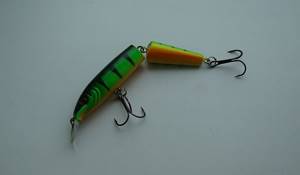
Where to look for pike?
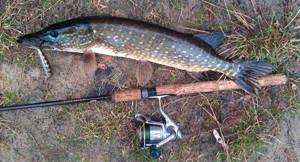
This representative of the ichthyofauna has outstanding adaptability to the environment: it can be found both in a small and almost overgrown reservoir, and in a turbulent, full-flowing river. She is not afraid of fluctuations in water level, oxygen saturation, and temperature. The main thing for her is the availability of a sufficient food supply.
As mentioned above, pike change their location depending on the season. There is a general principle for determining the sites of a predator: in the summer it is looked for in algae, in other seasons of open water - in places of certain anomalies. At the beginning of winter, pike prefers to live in dry thickets of reeds, but over time it moves to wintering pits, on the dumps of which peaceful fish look for food. The predator always stays where there is someone to prey on.
The most promising places for pike fishing are:
- boundaries of sedge and reed walls with free water;
- windows of water surrounded by vegetation;
- drifts and a sloppy bottom with a gradual rise;
- hydrological structures;
- shade areas under trees overhanging the water;
- boundaries of currents, with a change in direction or intensity.
The best silicone lures for pike
In the form of a review and as an example of the most popular and reliable baits in terms of quality and stability of catch, we have compiled a rating of models recommended for collecting a pike fishing arsenal, which will help the spinner to quickly and efficiently understand today’s huge range of similar fishing accessories with the greatest benefit.
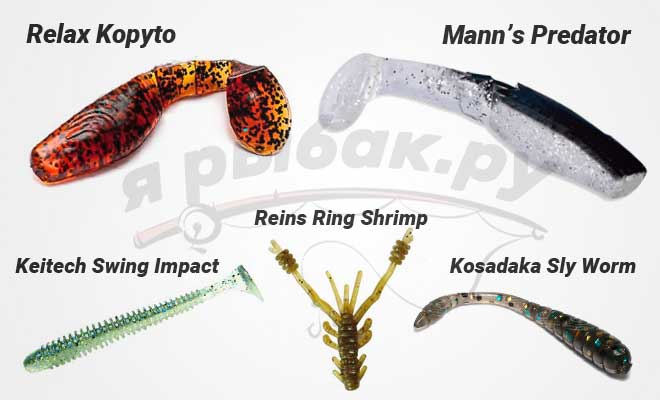
- Relax Kopyto is our top winner. These baits are characterized by a tall and thin body and a notched tail. Silicone bait is dense in structure and resistant to damage. An acceptable price level for a consumer is one of the components of a brand’s success.
- The second line for the classic spinning fishing Mann's Predator only for the differences from the leader in the higher price. Time-proven efficiency, as well as the quality of rubber, are undeniable. Pike, pike perch, and large perch in the catches can only speak of the versatility of the product.
- Kosadaka Sly Worm a high position for the resistance of silicone to pike teeth. The tough worm is capable of withstanding more than one attack, and the skills in its competent animation contribute to the bycatch of other predatory fish species.
- The fourth line is for Keitech Swing Impact - this elongated model of a vibrating tail, close to the body of the worm, works well on large pike in the summer near thickets. The manufacturer sells the model in fishing nets in various variations of color and odor attractive to pikes.
- Reins Ring Shrimp rounds out the top five in the ranking. This silicone is capable of catching both a large predator and can even bring peaceful fish as bycatch. The uniqueness of the simulator's game guarantees positive results for the fisherman.
- In sixth place we put Ballist 63 . A combined attachment that combines a worm and a twister. It makes alluring movements that resemble the behavior of a leech. Edible food in the middle zone of our country is promising with the smell of shrimp.
- Bait Breath Micro Grub . The model was ranked seventh for its good catchability of medium-sized pike throughout the entire period of open water. The manufacturer offers the fisherman a product in various exotic colors.
- The eighth line is given to silicone Deep Pearl 100/016 . Large-sized vibrating tail for hunting for a real trophy. Silicone has the ability to absorb attractant and the most effective scents for pike will be the smells of shrimp and mackerel, which has been tested in practice.
- The ninth position is for Bait Breath Mosya - this is a medium-sized bait made of edible rubber, which is a crustacean with a corrugated surface. Suitable for fishing for grass pike.
- Rounding out the top ten is the Reins Ax Craw Mini - this imitation of a crustacean creature with wide claws works great for pike in the autumn. The model has about a dozen color differences, which are selected based on fishing conditions and fish preferences.
Basic lures
All lures for pike can be divided into two broad categories: live and artificial. Sometimes a predator can be caught using a worm or maggot (especially during the period of changing teeth), but this is rather an exception to the rule: in most cases, it is interested in living and active prey.
When fishing with a spinning rod, only artificial baits that imitate small fish are used. It can be:
- Spoons (rotating and oscillating). There are many types of spinners, varying in shape, weight, and the presence of additional elements. In this case, spinners are selected depending on the type of wiring and the characteristics of the fishing rod.
- Wobblers. Unlike the previous group, these baits are not made of metal, which expands their model range and variations in external design. Moreover, some models are equipped with acoustic elements that attract passive fish.
- Soft baits . Soft baits are mainly silicone twisters and vibrating tails with weighted heads, used for jig fishing for pike. Occasionally foam rubber “fish” are used.
A separate group includes winter artificial baits: vertical spoons and balancers, rattlins .
For passive fishing, live bait . When selecting it, you should take into account the degree of its survivability: pike prefers active prey, it ignores dead fish. Small crucian carp, carp, loach, gudgeon, and roach are ideal. However, you need to focus on the basic food supply of the reservoir: the predator is more willing to eat familiar food. This explains the success of frog : if there is a toothy torpedo and a lot of these amphibians in the pond, fishing will be successful.
Silicone lures for pike and their characteristics
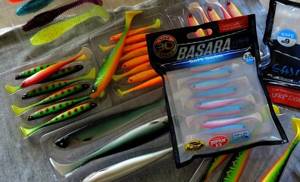
The diverse family of silicone baits is divided into four main directions, all of which work quite effectively for pike spinning fishing. They are divided into vibrotails, twisters, slugs and rippers. If the first three types go on sale without hooks and hooks built into the body, sometimes only elements for connecting the simulator to the cord can be embedded in them, then rippers have a complete, final package with their own hook and hook.
As a rule, each type of silicone is supplemented with notches and grooves applied by the manufacturer either throughout the body or on individual parts that cause vibration and sound. The distinctive properties and qualities of the bait are the shapes, sizes, colors and dynamics of the working body of the simulator, which in most cases is the tail, on which attractiveness and play directly depend. It is on these main characteristics that we will focus the reader’s attention as we further present our article.
Shape and size of bait
For pike spinning fishing, the best form of silicone is suitable, its appearance reminiscent of a medium-sized fish with a tall body, which in nature is a natural hunting object for the toothy one. In some conditions, especially with high fish activity, good results are shown by types of imitators that replicate large and thick worms. Fancy types and variants of similarities of crustaceans, amphibians and small rodents are not so successful for catching pike, although this does not in any way affect the ability of the spinning angler to experiment with forms in moments of no bite, looking for a promising option.
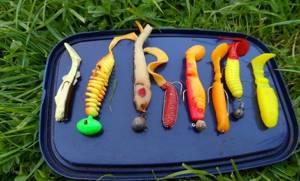
Important! Regarding the size of pike silicone, it is worth noting that active fish are capable of attacking a bait two-thirds of its length, so don’t skimp on lures for pike fishing.
It is convenient to catch grass fish with silicone fish 10–12 cm long. Initially, when planning to catch a truly trophy specimen, they try to install silicone from 15–20 cm and above, although for catching a trophy this is not a dogma and there are frequent cases of catching a couple of kilogram pikes onto ten centimeter silicone.
Color
The use of color variations of baits depends on a number of fishing conditions and, in particular, on weather conditions, which is determined by the intensity of lighting at the time of fishing, water transparency and the depth of fishing. Silicone itself has a very wide range of colors, ranging from pure colors and tones to a variety of mixing of colors both on the entire body and on its individual elements.
Important! What makes silicone fish more promising is the addition of glitter or fluorescent in the paint that changes color depending on the lighting.
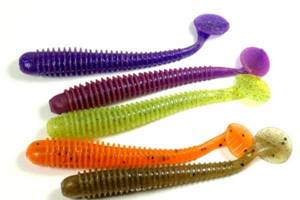
Pike are very successfully baited with such coloring techniques. On clear sunny days, dull colors work better, and on cloudy days, vice versa . In muddy waters and at depths, bright colors are more noticeable than natural colors, which is what you should be guided by when collecting baits of different colors, but identical in shape, into your arsenal.
Tail performance
By the structure and size of the silicone's tail, you can visually determine her playing style. So the wide and long tails of twisters behave freely in the water, playing with a wide amplitude of deviation from the main body of the bait, which can seduce passive and cautious fish. In vibrating tails, the work of the tail is more dynamic and is characterized by a high, but short frequency of horizontal movements, which irritates the active fish, immediately tearing it from its resting place to attack. For pike fishing, it is best to choose silicone with a massive and powerful tail, regardless of the type of attachment, which is visible to fish from long distances.
Open water fishing methods

Methods for catching pike in open water can be classified in different ways:
- Dislocations. Options include fishing from the shore or boat (rod, spinning rod) or passive fishing using a watercraft (installing circles, servicing donks).
- Degrees of angler participation. Most often we come across active pike fishing using spinning rods. Passive methods include bottom gear, a float fishing rod, and all kinds of stationary and floating girders. In other words, active fishing involves the use of artificial baits, passive fishing involves the use of live bait in all forms.
- Availability of a fishing rod. Tackle with fishing rod – spinning rod, live bait rod. The rest of the gear for pike does not have a rod (a bottom fishing rod with a blank is practically not used for hunting this predator; classic gear or a variation with an elastic band is used).
As you can see, there are a lot of options to choose from. When choosing the most suitable method of hunting a predator, you should focus on the conditions of local water bodies, financial capabilities that determine the selection of ammunition, as well as the physical condition of the fisherman. Now let's talk about this topic in more detail.
Spinning
Spinning is, although the “youngest”, but the most popular tackle for catching predatory fish. It is a fishing rod of fairly modest length, equipped with a spinning reel with a main cord, to which an artificial bait is attached via a leash. The bait is selected in accordance with the characteristics of the fishing rod and fishing conditions. One of the fundamental factors is the type of wiring: casting, twitching, jig, trolling and so on. Jig wiring is the simplest to perform, and a silicone bait (especially with an attractant) attracts pike even during a period of passivity.
All types of fishing lines are used for pike fishing, but their effectiveness depends on the season and conditions of a particular reservoir. They can be produced both from shore and from a boat. The only exception is trolling, which a priori requires the use of a motorized craft. In most cases, shorter rods are selected for fishing from a boat, since casting range in this case is not so important.
Spinning fishing is productive in all seasons of open water, but you need to take into account the nuances of spawning restrictions, when in most regions of Russia the use of this gear is prohibited. When carrying out postings, you should take into account the nuances of the bottom topography (for example, stepped jigs in conditions of a stuck bottom are difficult) and the degree of activity of the predator. In conditions of limited visibility due to turbidity of the water, it is recommended to use the brightest baits with noise effects.
Live bait fishing rod
You can also catch pike with a float rod equipped in a special way. For this purpose, a powerful telescopic rod of sufficient length is used, which allows casting into windows of clean water. If conditions permit, it is better to use a boat to increase the number of available seats.
This technique is most productive in the summer, when pike settle into summer quarters. It is especially effective in conditions of heavily overgrown reservoirs and small rivers with not too intense flows. During this period, the predator is spoiled by an abundance of food and reacts only to live bait served right under its nose.
It is most rational to use thin, unnoticeable installations in water. It is better to replace a metal leash with fluorocarbon braid: it is better to sacrifice the reliability of the equipment in favor of its delicacy. The rig uses special live bait floats, loaded up to the antenna, and relatively small treble hooks; you can also use singles and doubles. It is better to catch live bait in the same reservoir where you will be hunting for pike.
Fishing is carried out in mid-water, and special attention is paid to the condition of live bait. After casting, it is advisable to wait for five, maximum ten minutes, and in the absence of a bite, move to another place. If the pike is not interested in the appetizing fish, it means that it is most likely not nearby.
Donka
Donka for catching pike is not very convenient: this is due to both the design of the gear and the habits of the predator. Let us remember that in summer pike like to stand in thickets, therefore there are simply no conditions for normal casting and fishing. Donks with fishing rods are practically not used for this purpose.
Catching pike with a donk in the classic or elastic-cushioned version is acceptable in free water conditions. For example, in the spring, when aquatic vegetation has not yet developed, and the pike is hungry for food, you can cast rodless bottoms along the shallows. However, do not forget that in some regions of the Russian Federation, donka fishing during the period of the spawning ban is allowed only if 1-2 hooks are used, and in others it is completely prohibited.
This option is also productive in cold autumn water, when a significant portion of the vegetation has already died off, and the pike goes out into free waters and accumulates protein reserves before wintering.
If you choose between a classic donka and an elastic band, preference should be given to the second option: it is much easier to maintain, does not require the use of a boat for repeated casts and creates much less unwanted noise.
Summer girders
Before us is the oldest equipment for catching pike - a supply pole. Its design is extremely simple. The basis of the zherlitsa is a primitive reel (made of a wooden flyer, plank, plywood or even a plastic bottle). A fishing line of sufficient strength is wound onto the reel; a leash is usually not used. A large-sized live bait hook, usually a double or tee, is attached to the end of the fishing line.
The tackle is loaded with fry (preferably one of the most tenacious ones, because supplies are often installed at night) and thrown into the water. A loop of free fishing line is attached to the reel in such a way that during a sharp jerk caused by a bite, it is released and the predator hooks itself. The reel can be secured both on the shore (on a tree or a specially made structure) and in the water, on a peg driven into the bottom.
A progressive evolution of the stationary vent is its floating version, colloquially referred to as a circle. The mugs are disc-shaped floats with sides painted in different colors, to which live bait rigs are attached. When biting, the circle turns over with its alternatively colored side up, and the pike hooks itself. Most often, mugs are used in the summer in still water, installing them in places where the predator is supposed to stop. However, there is a method when floating girders are set adrift and followed by a boat.
How do you catch pike in winter?
As mentioned above, pike hunt almost all year round, with the exception of a two-week fast during spawning. With the onset of winter, it does not lose activity: experienced fishermen know what enviable specimens they take on the first ice not far from the shore - fishing is limited only by considerations of their own safety.
With the onset of deep winter, the predator shifts from the remains of coastal reeds towards wintering pits, where representatives of the carp family stand, representing the maximum gastronomic interest for it. During periods of sudden changes in weather, blizzards and strong winds, pike loses activity somewhat. At this time, you should make a choice in favor of delicate equipment and feeding the holes with mixtures with the addition of dry blood.
In clear sunny weather, even in severe frost, the pike begins to actively feed again, so you can return to traditional metal and Kevlar leashes. On the last ice, the bite intensifies even more: the predator prepares for spawning and feeds heavily, replenishing its energy reserves.
The most common winter gear is nodding fishing rods with artificial baits and live bait. In open water, you can use the winter variation of spinning.
Fishing rod
It is best to catch predators with a fishing rod during the periods of the first and last ice: in the dead of winter, this method of catching is not very productive. The baits used are usually vertical spinners and balancers. It must be taken into account that fishing is carried out vertically, and it is advisable to test all layers of water. Rattlins, which are bladeless balancers, are especially good for such initial reconnaissance. When fishing on the last ice, it is recommended to supplement the artificial bait with a worm or a piece of meat.
Universal rods are not suitable for pike fishing: a massive predator will instantly render a flimsy form unusable, so you should choose a reinforced version. A nod is used as a bite signal. If you are fishing with live bait, you can also use winter float equipment.
The productivity of fishing depends not only on the activity of the fish and the correct choice of place, but also on the skill of the fisherman. When vertical trolling is used, the bait is played directly near the bottom, with an amplitude of about 30 centimeters. An interesting option is a tube spoon: thanks to its design features, it not only moves vertically, but also slightly prowls in the water, further attracting the toothy hunter.
The balancer is played in a similar way, but it is also tapped on the bottom, varying the amplitude and periodically pausing. The predator usually attacks the bait on the rise. The more passive the pike, the softer and more delicate the game should be, but do not forget - we are dealing with a completely unpredictable fish.
It is advisable to drill several holes and fish them one by one, in the hope that the pike is loitering somewhere nearby. When searching for a site for this representative of the ichthyofauna, it is best to use an echo sounder, since visual identification of bottom anomalies under the ice is almost impossible.
Winter spinning
Experienced fishermen know that the activity of pike only intensifies with the onset of the first frosts. At this time, the ice is still unreliable, and huge areas of water remain completely open. Due to global warming, some rivers are not covered with a continuous layer of ice even in the dead of winter, so the use of spinning rods is quite possible.
The obvious advantage of this option is minimal competition and the absence of aquatic vegetation that complicates wiring. And among the disadvantages, first of all, it should be noted the discomfort for the fisherman (hands freeze very quickly) and the inaccessibility of many visually attractive places.
Winter equipment differs little from summer equipment, but there are still some nuances. Let's start with choosing a fishing rod - common carbon fiber does not withstand significant frosts. The second problem is with the coil: on some models the overrunning clutch simply does not work in such conditions, so it’s worth paying attention to other design solutions. It is definitely worth treating the elements with frost-resistant grease. The main fishing line is braided material of maximum density, preferably impregnated to protect against freezing.
In winter, pike are caught mainly with silicone baits and foam rubber, using the jig method. The greatest efficiency is demonstrated by classic steps, slow dragging along the bottom, and slow retrieves with hangs. The animation should be blurry, but quite expressive.
Zherlitsy
Before us is the most promising option for catching a toothy predator in the dead of winter, when other methods are ineffective. Winter vents, for the most part, have a more complex structure than summer ones.
Despite the abundance of design solutions, the most popular are “flags” that are installed directly on the hole, simultaneously protecting it from freezing. A vent of this type consists of a platform (usually disk-shaped), a stand with a coil attached to it (regular, inertial) and a flexible rod with a flag, usually orange or red. The equipment involves the use of live bait.
The process of charging the gear occurs as follows. Live bait is attached to the hook so that it is located at a distance of about 10-15 cm from the bottom. The line on the reel is fixed with a flag. When there is a bite, the line unwinds, the flag is released and flies up.
The greatest difficulty in this case is the need to drill a large number of holes. Typically, girders are installed in two rows with an interval of up to 10 meters along the shore. If the pike stubbornly does not want to be caught, they are moved away from the shore. Again, there is a need for an echo sounder and an ice auger with an electric or fuel engine. But if you have sufficient funds to purchase the appropriate equipment, this type of fishing will give you a lot of positive emotions.
Pike is a worthy opponent, a fight with which can fill your blood with adrenaline and your heart with the joy of victory over a strong and cunning predator. We wish you to get more luxurious trophies and promise to continue to delight you with useful publications!
Fishermen wonder why I’m biting and they’re not?
I’m revealing a secret just for you: it’s all about the miracle bait! More details
Wiring a silicone bait when fishing for passive pike
Having decided on the bait (in our case it is a passive silicone bait), you need to choose the type of wiring. And again, remember and take into account the following: the pike stands in ambush so that it can see the future victim from above itself. Hence the priority of a light-weight jig head and, accordingly, the slowest retrieve. Sometimes dragging along the bottom wins, but a more acceptable retrieve is 5–10 cm from the bottom with smooth pulls and pauses of up to 3 seconds. Also, we should not forget that when fishing for pike you need to fish a promising place from several points. This will work if you are on a boat. If fishing is done from the shore, then try to fish the place at different angles to the shore. Make casts to the left, to the right, perpendicular to the shore.
When a silicone bait is equipped with a hinge with a “eared” sinker, the bait takes on a more lively appearance during the animation process, which, you see, cannot but affect the effectiveness of the fishing itself. And the wiring in this case looks like two or three smooth lifts of the tip of the spinning rod from 10 o’clock to 11.30 with reeling in the cord. At the same time, during pauses, it is necessary to give slack to the cord and pause after the bait touches the bottom for 2-3 seconds.
But the water cooled down even more (4–6 C), and the pike began to “be capricious.” Pike bites became rare or disappeared altogether. There are several explanations for this, as well as ways out of this situation. The fact is that as the water gets colder (November - December), the metabolism of pike and other fish slows down. She continues to feed, but not as actively as before, and this cannot be ignored. The pike will no longer chase after a quickly drawn bait, but will wait until the prey comes to it itself or passes by very slowly, with long stops. The wiring can be left the same, but the amplitudes should decrease. The bait should “jump” literally in one place and low (maximum 8–10 cm from the bottom), and the pauses should increase to 5–8 seconds. For pike, it is better to bait the bait with the same wave-like wiring, but with a smoother and slower amplitude. There are frequent cases of pike biting during a prolonged pause. Well, let's say you received a call, and while you are talking on the phone, the silicone bait lies motionless on the bottom. At this moment the pike bite occurs.
